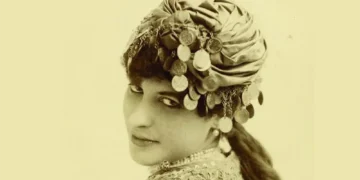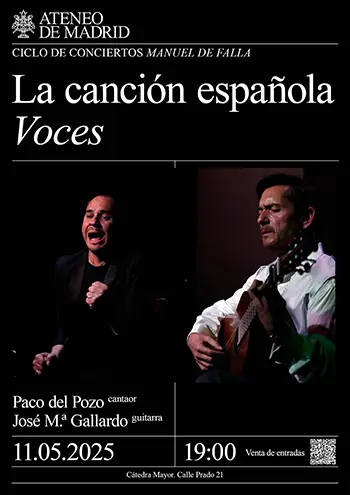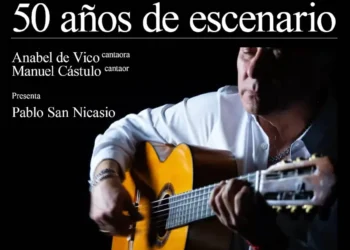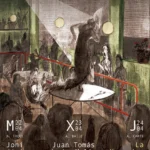|
| Coverage of the Festival Flamenco USA is sponsored by Arte Fyl Dance Shoes |
| Calzados de Arte Fyl: art for the Art Professionals know |
Text: Mona Molarsky
Classical guitar: José María Gallardo. Flamenco
Guitar: Cañizares. Bass: José de Lucía. Percussion:
Roberto Vozmediano.
Call it a dialogue, call it a
beverage, call it nuevo aguardiente, or whatever
you want…but please don't utter the word «fusion.»
Juan Manuel Cañizares, the flamenco guitarist from Sabadell
in Catalonia and José María Gallardo, the classical
guitarist from Seville, went mano a mano, Spanish for the
facing-off of equals, at Carnegie Hall's Zankel auditorium in New
York on Thursday, February 10th, in a concert that owed its success
more to camaraderie than to competition. Only a handful of New York's
local flamencos were to be seen last night. But the many music lovers
and guitarists in the audience were enthralled by the two virtuosos
and their «bilingual» duets that seemed to funnel two
distinct languages into one heady concoction.
Each guitarist played solo early in the program. Gallardo, who
embodies the sunny, fun-loving temperament of his native Seville,
tossed off a classical Danzas Españolas and had
fun with his lyrical and humorous Lorca Suite (based on Canciones
Populares Españoles). Like the Lorca Suite, his short,
fast-paced Fuego was accompanied by Roberto Vozmediano's
delicate cajón, to good effect.
«Bilingual» duets that seemed
to funnel two distinct languages into one heady concoction.

displayed a darker side in his modernist Minera, in which
he seemed to explore with his guitar some of the places singer Enrique
Morente has explored with his voice. With La Pajarraca,
a bulerías, Cañizares at first seemed to
move into a more traditional flamenco mode, but soon, his unsettling
falsetas reminded us this was no fiesta in Jerez. When he turned
180° to ride a jazzy colombiana, it was with the jaunty
ease of a New World cowboy. He was backed up by Roberto Vozmediano's
percussion and José de Lucía on bass, adding to the
popular feel. For four years in the late eighties and early nineties,
Cañizares toured with Paco de Lucía's trio and, especially
in the lighter of the flamenco forms, you could hear the influence.
“Todos mamaron de Paco”, a typically graphic
Spanish phrase meaning ‘All the young guitarists suckled at
Paco de Lucía’s breast’ “and they'll be
the first to say so,» commented veteran flamenco dancer Liliana
Lomas who attended Paco's solo debut in Jerez in 1970, and was sitting
next to me last night. As the lights came up for intermission, she
was smiling, enjoying the show.
Dialogues between two voices –
the bright, classical guitar of Gallardo and the darker, flamenco
guitar of Cañizares.
More than the solos, though, it was the Gallardo-Cañizares
duets that sparkled last night. Before this year's Flamenco Festival,
the two had never played together. They staged this mano a mano
at the director's request. Listening to their perfect compás
and watching their smiling faces, though, I never would have guessed.
What a pleasure to see two such different artists have so much fun
together! They performed Gallardo's high-spirited Sevilla,
Manuel de Falla's La Vida Breve, then Coast Redwood,
a colombiana arranged by Gallardo, then Cañizares’
ballad Lejana. Many of the pieces were essentially dialogues between
two voices–the bright, classical guitar of Gallardo and the darker,
flamenco guitar of Cañizares.
What do you call this particular amalgam of flamenco and classical
(with its seasonings of jazz and even progressive rock) cooked up
by these two guitarists? Call it a dialogue, call it a beverage,
call it nuevo aguardiente, or whatever you want…but
please don't utter the word «fusion.» The very intelligent
and articulate Cañizares has gone on record insisting he's
flamenco to the bottom of his soul, incapable–as much as he might
wish otherwise–of fusing two traditions into one. If you didn't
know better, you might think you were listening to the nostalgic
rantings of a crank, one of those hopeless old curmudgeons from
flamenco puro crowd. In fact, with Cañizares, nothing
could be further from the truth.
Like falling in love with a man, falling
in love with a music defies reason and logic
But, now that I've mentioned flamenco puro, I have a confession
to make. At heart, I am one of those cranks. Despite my admiration
and respect for today's artists who are pushing the boundaries of
flamenco, I am in love with the old, pre-Paco stuff. And would trade
all the fast finger work and tonal experiments in the world for
one classic siguiriya that could make me weep. Like falling
in love with a man, falling in love with a music defies reason and
logic. Once a certain music speaks to the secret part of your soul,
nothing else–no matter how beautiful, new or shiny–seems to come
anywhere close. So it was for me that, during the last third of
last night's concert I began shifting in my seat and checking my
watch. Don't get me wrong. Those final duets between Gallardo and
Cañizares, the bulerías, the waltz, the tangos
and the rumba were very good. There was real spirit
between the men. And a fun time was had by all. The audience gave
the guitarists a standing ovation and they were rewarded with a
waltz by Venezuelan composer, Antonio Lauro as an encore. It's just
that, by the end, I was somehow left feeling…well, hungry.
«At times like this, I really miss Diego del Gastor,»
murmured an old time aficionada on my left. And, although
I never had the pleasure of meeting that unschooled guitarist with
the impeccable compás, who played strictly from his heart,
I knew exactly what she meant.
by Mona Molarsky © 2005. All rights reserved..
Photos by Jess Ugalde
|
'Noches de Imán y Luna' |
|
Isaac Albéniz. Sonatas para piano, 3 y 5 |
|
'Punto de encuentro' |
|
La Maestranza. En directo desde la X Bienal de Flamenco |
|
|































